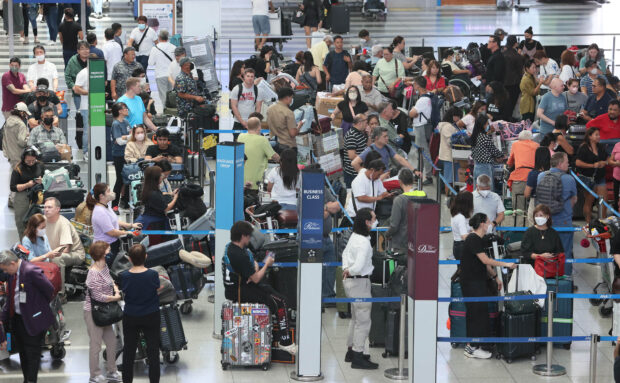
Passengers wait in line at a check-in counter a day after the NAIA terminal 3 experienced a power outage on the morning of Monday, May 1, 2023, causing delayed flights and cancellations. (Photo by MARIANNE BERMUDEZ / Philippine Daily Inquirer)
MANILA, Philippines — The entire Philippine airspace will shut down for six hours on May 17, from 12 a.m. to 6 a.m., to make way for the replacement of the uninterruptible power supply (UPS) system that failed on New Year’s Day and led to a massive disruption of operations at Ninoy Aquino International Airport (Naia), the country’s main gateway.
Bryan Co, senior assistant general manager of the Manila International Airport Authority (MIAA), in a press briefing on Tuesday said the maintenance activity had been coordinated last week to give the airlines “lead time” in recalibrating flight schedules and informing their passengers.
The MIAA will meet with the Civil Aviation Authority of the Philippines (Caap) and other airport authorities on Wednesday to hear the plans of the airlines in response to the scheduled maintenance of the Communications, Navigations, Surveillance/Air Traffic Management (CNS/ATM) system.
“These are all proactive efforts to make sure that the CNS/ATM is reliable as an offshoot of what happened earlier this year,” Co said, referring to the Jan. 1 aviation mess that affected around 56,000 passengers and 361 domestic and international flights to and from Manila.
The technical glitch in January that shut down the country’s airspace happened after a UPS unit failed to work because one of its cooling blowers conked out.
On Monday, the Labor Day holiday, an eight-hour power outage disrupted operations at Naia Terminal 3, leading to flight delays and cancellations that affected more than 9,000 passengers.
Advisory sent early
In an April 28 advisory, Caap informed the public of the corrective maintenance activity scheduled on May 3, from 2 a.m. to 4 a.m., and May 17, from 12 a.m. to 6 a.m., that would result in the suspension of operations at the Philippine Air Traffic Management Center (ATMC), which houses the CNS/ATM system.
Caap said the maintenance would involve the repair of the automatic voltage regulator (AVR), replacement of the UPS, and upgrade of the air traffic management system power supply.
“An AVR functions as a protection against surges as it regulates the voltage delivered to devices and a UPS ensures equipment has uninterruptible power supply,” it said.
It will affect the flights at Naia, Clark International Airport, Mactan-Cebu International Airport, and several flights in 42 other airports operated by Caap.
“The earlier that the airlines can advise the passengers, the better because of these planned changes in their itinerary,” Co said.
For six hours on May 17, he said there would be no activity in the entire Philippine airspace but if the maintenance would be completed earlier, the Notice to Airmen would be lifted immediately and the operations at the ATMC would resume.
“Let’s say the flight is supposed to arrive in Davao by 12 a.m., [the plane] should be there in Davao by 12. So its last flight out of Manila would be around 10:30 p.m. because … it would take an hour, an hour and a half to get to their destination or to leave the Philippine airspace, whether they are going westbound to Vietnam or eastbound going to the Pacific,” Co said.
BACK TO NORMAL | A plane lands at Ninoy Aquino International Airport in Pasay City on Tuesday, May 2, 2023, as normal operations resume a day after an eight-hour power outage hit the airport’s Terminal 3. A scheduled maintenance activity on May 17 will stop airport operations for six hours. (Photo by GRIG C. MONTEGRANDE / Philippine Daily Inquirer)
In the morning, the MIAA anticipates that the first arrival of inbound flights would be around 7 a.m. to 7:30 a.m. since the airspace would open by 6 a.m.
MIAA General Manager Cesar Chiong, in the same briefing, said they would urge the airlines to notify all passengers about the possible rescheduling of flights “because if the passengers are advised, I don’t think there’s going to be a problem.”
Meanwhile, House Deputy Minority Leader France Castro said the public could not be blamed if they would suspect that the May 1 power interruption at Naia 3 was done on purpose to hasten the airport’s privatization.
“The P100-billion unsolicited proposal to rehabilitate the Naia was just recently announced, then we have this power outage. We cannot fault the public for thinking that this was intentional to hasten the sale and privatization of the Naia even if the public was not consulted—yet they will be the ones to shoulder the cost,” she said on Tuesday.